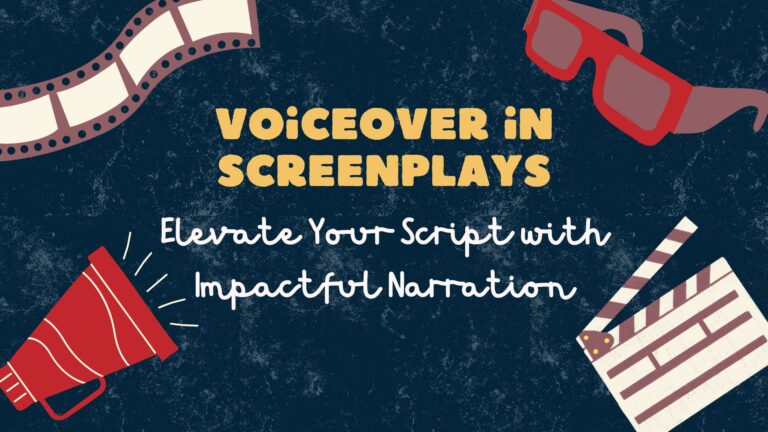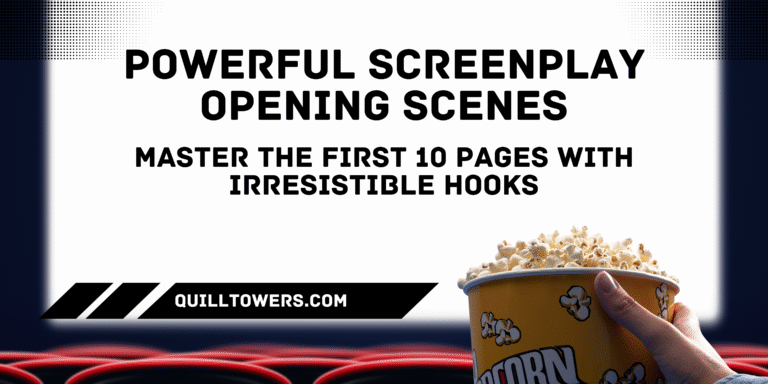10 Screenwriting Mistakes to Avoid as a Beginner
“Mistakes are a fact of life,“ poet Nikki Giovanni once said. “It is the response to error that counts.” When it comes to screenwriting mistakes, your response can determine whether a script gets tossed or noticed.
Ever stare at your script, thinking something feels off? You’re not alone. Almost every first-time screenwriter fumbles into the same traps: awkward formatting, sluggish scenes, and confusing structure. But the good news? They’re all fixable.
In this guide, we’ll unpack 10 common screenwriting mistakes, the kind that silently sabotage your story and walk you through innovative, actionable ways to avoid them. If you’re just starting, this insight will save you from endless do-overs.
Let’s dive in and get your script back on track.
Ignoring Proper Screenplay Formatting
Improper formatting isn’t just a beginner move; it can cost your script’s credibility and readability fast.
Why It Matters
- Readability: Clean formatting lets the reader picture your story effortlessly.
- Professionalism: Studios, agents, and festivals insist on industry-standard structure.
- Feedback Clarity: Clean scripts invite sharper problem-spotting and suggestions.
Top Tips for Formatting Like a Professional:
- Use dedicated tools (Final Draft, Celtx, Arc Studio) to auto-format margins, font (12pt Courier), and scene headers.
- Study real scripts from successful films to internalize layout conventions.
- Keep formatting consistent, don’t mix spacing styles or font sizes midway through the draft.
Script vs Screenplay: What’s the Real Difference?
Starting the Script Too Late or Too Early
One of the most common screenwriting mistakes beginners make is mistiming the start of the story.
If your plot doesn’t truly begin until page 15, you’re already losing your audience.
The Mistake:
- Opening with long, slow scenes that add little to the story’s forward momentum.
- Starting too early, spending pages on unnecessary backstory or setup.
- Waiting too long to introduce the conflict or inciting incident.
How to Fix It:
- Start In The Middle Of The Story: Dive directly into the action, tension, or central conflict.
- Trim Your First Five Pages Ruthlessly: Ask if the story needs this to begin?
- Study Tightly-Paced Films: Films like John Wick or Get Out. They hook viewers from the first five minutes and keep the stakes high.
- Remember: Producers and contest readers often decide within the first ten pages whether to keep reading.
By cutting the fluff and entering the story at the right moment, you’ll make your screenplay sharper, more engaging, and far more likely to stand out.
Weak or No Story Structure
Starting your screenplay with a limp opening is like showing up to a job interview in flip-flops; you lose credibility fast. One of the most common screenwriting mistakes beginners make is underestimating the importance of structure.
Think of your screenplay’s structure as the frame of a house. Without a sturdy frame, everything collapses.
A standout opening scene should:
- Establish Tone: Is it dark, light or suspenseful? Nail the vibe from page one.
- Introduce Conflict: Even subtle tension gets the reader leaning in.
- Reveal Character: Show a glimpse of your protagonist’s drive and personality.
- Create Visual Impact: Aim to paint a picture with action, not exposition.
Use a technique I call “magical cookies”, which are little surprises or emotional hooks sprinkled early on to keep readers engaged.
Best Practices:
- Follow a Three-Act Structure: Hitting the inciting incident by page 10–12, the midpoint around page 60, and the climax near the end.
- Avoid Aimless Scenes: Every moment should serve a purpose.
- Use Tools: Utilize tools like Save the Cat templates to enhance pacing and clarity.
By committing to structure, you turn a shaky opening into a scaffold for a story that stands tall.
Flat or Overwritten Dialogue
Dialogue should be a real conversation, not a play-by-play of the plot. One of the biggest screenwriting mistakes is writing stale or info-heavy dialogue that makes characters sound robotic.
Bad dialogue pops like a balloon at a serene picnic; it jolts your reader out of the story.
To sharpen your dialogue:
- Less Is More: Trim the fat. Keep lines short and meaningful.
- Aim for Authenticity: Include pauses, interruptions, and imperfections, just like in real talk.
- Show, Don’t Tell: Let actions and subtext do the heavy lifting.
Practical Tips:
- Read your dialogue aloud to test flow.
- Listen to honest conversations or watch scenes that resonate with your genre.
- Ask yourself: What would my character never say? This helps define their voice.
Clear, honest dialogue enriches your characters and keeps your story moving.

Telling Instead of Showing
In screenwriting, telling is the enemy of showing. Relying too much on dialogue turns your screenplay into a stage play, not a cinematic experience.
Scenes should unfold visually, like a painting coming to life frame by frame.
How to Embrace Visual Storytelling:
- Imply Through Action, Don’t State Through Dialogue: Replace “She’s sad” with vivid imagery: Tears well up as she holds her mother’s scarf.
- Use Visual Cues: Let props, settings, costumes, and movement speak volumes.
- Economize Dialogue: Focus on action, exits, and visuals for emotional weight.
This approach keeps readers hooked and also solves one of the most common screenwriting mistakes, leaning heavily on dialogue when visuals can do the work. By tightening your structure, tone, dialogue and visual storytelling, your writing becomes clearer, more professional and more enjoyable to read and perform.
Underdeveloped Characters
Subplots are like the side streets in a city; they should lead somewhere relevant, not confuse the tourist.
One of the top screenwriting mistakes beginners make is introducing subplots that never connect back to the main storyline. It’s like building bridges to nowhere; your story ends up scattered, and the emotional impact gets diluted.
How to enhance your subplots:
- Tie Them To The Main Journey: Every subplot should test your protagonist or reveal more about their arc.
- Use Them To Build Character: Secondary characters get their moment in the spotlight, show their motives, fears, or hidden sides.
- Keep It Tidy: Too many subplots scatter focus. Stick to a few meaningful ones.
Ask yourself: What does this secondary character fear most? That fear can become the engine of a subplot that supports your central theme.
By weaving strong subplots, you turn a flat story into a richly layered narrative.
Writing Without an Outline
Going without an outline in screenwriting is like sailing without a compass; you’ll drift, stall, or run aground.
Most beginners treat screenwriting like freehand painting, aka “pantsing.” The reality? It rarely works. One of the biggest screenwriting mistakes is jumping in without a roadmap.
Why outlining matters:
- Prevents middle-of-act slumps by stating your major beats early.
- Frees your mind to focus on dialogue, emotion, and visuals because the structure is already mapped.
- Allows you to adapt mid-process, if inspiration strikes, you can pivot without losing shape.
Tools that save your skin: beat sheets, scene cards, or even a whiteboard with your plot’s key events.
Overuse of Parentheticals & Transitions
If parentheticals and transitions were candy, beginner writers would binge eat them. But in scripts, they’re more like monosodium glutamate (MSG), a little can enhance the flavor, but overuse quickly ruins the dish.
This is a classic screenwriting mistake: overusing parentheticals like “angry” or transitions like “CUT TO“ where the context already provides clarity. That clutter distracts and frustrates readers.
Common pitfalls:
- Adding emotions or actions already evident in the scene.
- Excessive use of FADE IN, FADE OUT, etc., makes the script feel stiff.
- Interrupting the rhythm of the dialogue and narrative flow.
How to fix it:
- Use parentheticals only when clarity demands it, especially in group scenes.
- If context already shows who’s speaking to whom, ditch the tagging.
- Let actions and context do the work, reducing unnecessary direction.
A polished, lean script that’s easy on the eyes goes a long way toward convincing readers and producers you know your craft.

Lack of Conflict or Stakes
A story without conflict is like a car without gas; it might look good, but it’s not going anywhere.
One of the most common screenwriting mistakes for beginners is writing scenes where nothing’s at stake.
Conflict is the heartbeat of storytelling. It’s what drives tension, builds drama, and keeps audiences glued to the page.
Why Conflict Matters:
- Internal Conflict: Characters battling themselves, moral dilemmas, emotional struggles, or self-doubt.
- External Conflict: Protagonists are up against other characters, society, nature, or time.
- Layered Conflict: The best stories mix both internal and external tensions to create emotional depth.
Ask yourself this: What happens if my character fails? If the answer is “not much,” then your stakes are too low.
Tips to Avoid Flat Scenes:
- Infuse every scene with tension or uncertainty, even if it’s subtle.
- Remember, stakes don’t have to be life-or-death. Emotional stakes, like losing a friend, missing a goal, or being humiliated, are just as powerful.
- Use mini-conflicts, such as tiny roadblocks or disagreements, to keep momentum alive.
- Conflict is what turns your story from a series of events into a page-turning emotional journey.
Quitting After One Draft
Finishing your first draft feels like crossing a finish line, but in reality, it’s just the first checkpoint. If writing is a marathon, rewriting is the ultra-marathon.
One of the deadliest screenwriting mistakes is thinking the job’s done after draft one. The truth? First drafts are supposed to be messy. The real magic happens in revision.
So, where do you start?
Step 1: Put It Away
Distance makes the flaws grow clearer. Give your brain a break, at least two weeks, maybe more. Start something new, let your subconscious simmer on it.
Step 2: Analyze with a Critic’s Lens
When you return, please don’t read it as the proud parent. Read it like a ruthless editor. Please print it out. Red pen in hand. Slash, burn, and scribble notes in the margins. Be petty. Be brutal.
Professional Tip: Use tools like Arc Studio for in-script commenting. Digital or analogue, whatever helps you get critical.
Step 3: Rewrite with Purpose
Now that your first draft looks like a murder scene in red ink, start rewriting. Focus on clarity, character arcs, theme, and pacing. Remember, writing is rewriting.
Beginner Warning: Never send your first draft to agents or contests. It’s not ready. You’ve only sharpened the blade; you haven’t started cutting.
Sharpen Your Screenwriting Skills Like a Professional
Even the pros keep learning. If you want to rise above common writing pitfalls, it takes practice, mentorship, and the right tools.
Here’s how to level up:
- Take Screenwriting Courses: MasterClass, UCLA Extension, or Sundance Collab offer game-changing instruction.
- Read Books: “Save the Cat” by Blake Snyder and “Story” by Robert McKee are foundational.
- Get Feedback: Join online groups or local workshops. Critique circles are gold for improving fast.
Remember that growth comes from consistent writing, self-reflection, and being open to learning, even when it stings.
Top Screenplay Contests Every New Writer Should Enter
Want honest feedback, industry eyes on your script, validation that you’re on the right track? Entering contests can do all that and more.
High Profile Screenplay Contests:
- Nicholl Fellowships: This is known for discovering fresh talent. Winning here is like striking gold.
- Sundance Screenwriters Lab: Ideal for indie storytellers with something bold to say.
- Austin Film Festival: Known for insightful feedback and top-tier networking.
These aren’t just competitions, they’re launchpads. Many writers have landed agents, managers, and deals through them.
Keep Writing, Keep Improving
Making screenwriting mistakes is part of the process. It’s a rite of passage. Every successful screenwriter has written unnatural dialogue, forgotten conflict, or sent out a premature draft.
What sets them apart? They kept going.
- Write, rewrite, and write again.
- Seek feedback. Accept critique.
- Push yourself past the doubt.
You’ve already taken the most crucial step: you care. You’re reading, learning, and trying to get better. That means you’re ahead of the pack.
Make Your Next Rewrite the One That Matters
At Quilltowers, we specialize in turning rough drafts into polished screenplays that stand out in competitions, writer’s rooms, and pitch meetings.
Whether you need developmental notes, format fixes, or complete rewrites, we’re here to help you dodge beginner screenwriting mistakes and write like a professional.
Let’s bring your story to life. Contact Quilltowers now!






